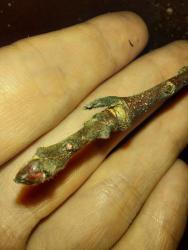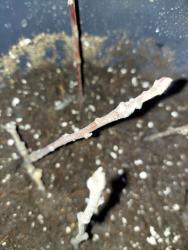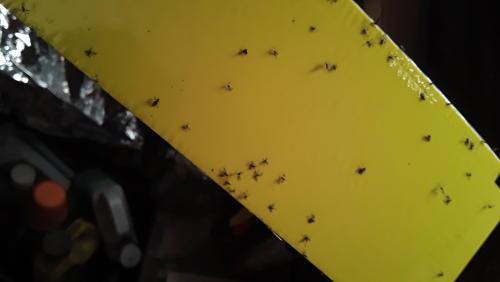RookiePresent said: the white stuff that was no doubt present when I took the cuttings from the trees.....
do I just keep at it? Is using that much fungicide on the cutting bad for them?
In my experience, the fungi (such as gray mold, etc) is far tougher to control with hardwood cuttings than with green (softwood) cuttings with leaves. And, the plant reproduction process is one of the very coolest of gardening experiences to witness because it's actually a battle between TWO of the fundamental principles of nature: one, the battle for a species to reproduce itself to save its race vs. the battle for nature to reclaim itself-to break down decaying wastes (via actions by bacteria and fungi) to insure future generations of plant have soil and nutrients for growth. It's a race you witness with your cuttings.
There's no secret answers to your dilemma of fungi... but some hints.
As the EPA states about household fungus (mold and mildew) problems
EPA.gov said:
Molds can thrive on any organic matter, including clothing, leather, paper, and the ceilings, walls and floors of homes...
So, no surprise that fungi spores that found your leftover hotdog buns, carefully still sealed in their bag, or your mac-n-cheese leftovers, sealed below plastic wrap in the back of the fridge, both grow mold when forgotten. So it goes with your 5 gal pot of 'leftover' apple sticks.
Fungi spores are in our environment.
Fungus growth on cuttings to me seems to involve three things, though: one) original source of the fungus, like a cutting, potting soil, etc, two) decaying organics to grow on, which 'feed' the fungus- like decaying bark on the cutting itself or organic material in the potting mix, and Three) high moisture.
The underlying item, of course, as Daisyl carefully examined before, is your success may not hinge on any of these things, but on the actual apple trees heredity, its DNA programming. Will it set roots and grow BEFORE ITS TISSUES succumb to decomposition? I haven't tried apple, but my research indicated apricot hardwood cuttings were similarly difficult to apple, which I have tried, but wasn't successful. Your experience may differ!
My suggestions:
1) Never give up! As I said, rooting cuttings is actual a very cool! Try easier hardwoods next such as figs, grapes or roses. Or softwoods next spring?
You said you attempted to form root callus... I would be interested in if you were successful in getting a callus on your apple?
2) remember that fungus spores are everywhere: on the surface of the bark, on your cutting tool blade, on the surface of your plastic pot, in the potting soil, on your hands, your watering can, etc. Sterilize what you can in advance, but unless you have a "clean room" as used in micro-propagation, you'll have fungi. Sanitizing your hard surfaces, both from bacteria and fungi (carefully and safely!) may help.
Simply, this may mean wiping cutting tool surfaces and hard surfaces such as plastic pots with rubbing alcohol or bleach water (as sterilizing hopefully kills both bacteria AND fungi, while 'fungicide' usually just kills fungi, or a specific fungus, or fungi at a specific growth stage. (See article referenced below.) Using 'soilless' potting media such as vermiculite or perlite, and monitoring humidity carefully are part of the 'simple' methods.
3) more advanced steps might include a 'cutting dip' of fungicide or dusting with a bulb dust before beginning storage for callus growth or when sticking for rooting. When fungi becomes a problem, fungicide applications help mitigate fungi already growing. You need to research carefully hese advanced methods for your safety and the best plant health. As noted by Daisyl, there isn't a lot of research showing how to be successful with apple hardwood.
Regardless, if you choose to continue fungicide use, here is a good article on fungicides, including "mode of action" and a notes on saftey, and another on sterilization practices.
Fungicide use:
https://hortnews.extension.ias...
Cleaning & disinfection:
https://extension.umn.edu/plan...
I highly suggest the sources you include are from university or professional sources, and counter the million "how to" blogs your google search will show, or even information from me.
That said, here is the 'questionable' information from me. I've never rooted apple, but tried really, really hard with a favorite apricot that the internet said wouldn't work. It didn't!
I use dusting / spray formulations of Sulphur, along with RELIANT systemic fungicide as a spray and dip for some of my cuttings and bulb propagation and storage. For sanitization, for years I've used a mild bleach solution or rubbing alcohol for sanitization of tools and pots. I've used both vermiculite and perlite, but have recently switched to coconut coir as my medium. (Never dirt or compost, both are just too dirty for cuttings, divisions or seedlings.) One time I tried the "sterilize your dirt in your oven" from some gardening blog... The procedure was quickly banned in my household.)
In all cases, I'm trying to use 'least toxic' measures for myself and my family, as we want indoor air clean of both chemicals AMD fungi spores.
What about cinnamon and all those other 'natural' methods? Give them a try if you wish, I just can't say they worked for me.
By all means, update this thread with what works, or what didn't, then we all know a little more.
You could try simple grafting. Plant those apple seeds, wait a few years, when new trunk is the size of a pencil, cut it with a razor blade (v-cut) inserting a greenwood cutting from the apple?
That's my new plan with my apricot....


